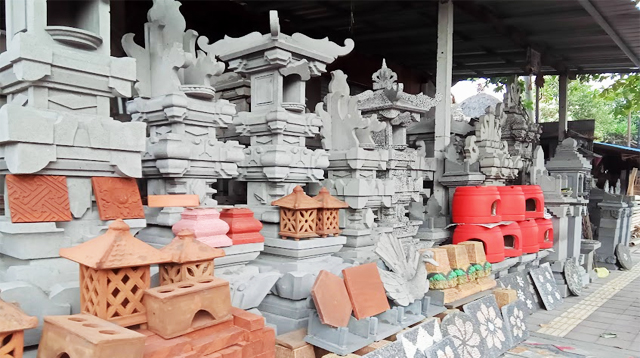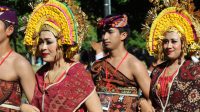ALMOST along the main roadside in the Kapal Village area, Mengwi, Badung, is filled with various handicraft products made from concrete, terracotta, wood, solid stone to palm leaves. In this way, the area seems to be the longest ‘showcase’ for arts and crafts products in Bali.
Well, Kapal Village has long been a sales center for various building, Hindu religious art and landscape products. Some are made by the Kapal Village community themselves while some others are supplied by producers from outside the village.
Religious art products
The main products sold here are items of Balinese traditional art and architecture, including shrine, temple buildings made of carved wood, classical walls and other derivative products.
The local craftsmen in Kapal Village do not only maintain traditions, but also inherit their skill in creating stunning works of art and various innovations adapted to the times.
Small shrines are example of the most popular forms of practiced art in Kapal Village. Each pelinggih or shrine has a unique and intricate design and ornaments, reflecting the rich culture and religion of the Balinese people. The use of precast materials allows for fine details and rich ornamentation to beautifully decorate each shrine.
Kapal Village is also famous for the production of temple buildings, which are places of worship for Hindus. These buildings were created by combining classic Balinese architectural art with a modern touch. Precast concrete allows craftsmen to create sturdy structures and maintain the artistic beauty inherent in Balinese building art.
There are also various types of statues, both sacred ones with Hindu mythology themes and contemporary ones to complement garden ornaments. There are even ones combined with contemporary models or with water feature.
Meanwhile, walls, as an important element in Balinese architecture as area dividers, are also available with various design motifs as well as gates and ornaments. In terms of materials, some are made from precast concrete, crushed stone, and even terracotta.
Making prefabricated craft items in Kapal Village involves a series of processes that require high expertise. From printing the initial model to the final touches, every step is executed with complete dedication. Traditional materials, such as sandstone and cement, are often used to create an authentic feel.
Palm leaf crafts
To complement the products above, palm leaf craft products are also available here for penjor making materials such as sampian and other accessories. So ahead of the Galungan celebration, people will be busy shopping for the penjor making needs here.
Respecting Cultural Heritage
Sustainability and cultural preservation are the main focus at Kapal Village. The craftsmen strive to maintain traditional techniques while combining them with contemporary innovation. Empowering local communities and a sustainable approach is the basis for preserving the rich cultural heritage of Kapal Village.
Kapal Village in Badung, Bali, is not just a beautiful rural area, but also the guardian of Bali’s rich cultural heritage. Prefabricated craft items, such as pelinggih, temple buildings and classical walls, not only reflect the beauty of Balinese art, but are also a valuable heritage that connects the past, present and future. As a visitor, immersing yourself in the beauty and craftsmanship behind these items pays tribute to the traditions and creativity of the Kapal Village people.











